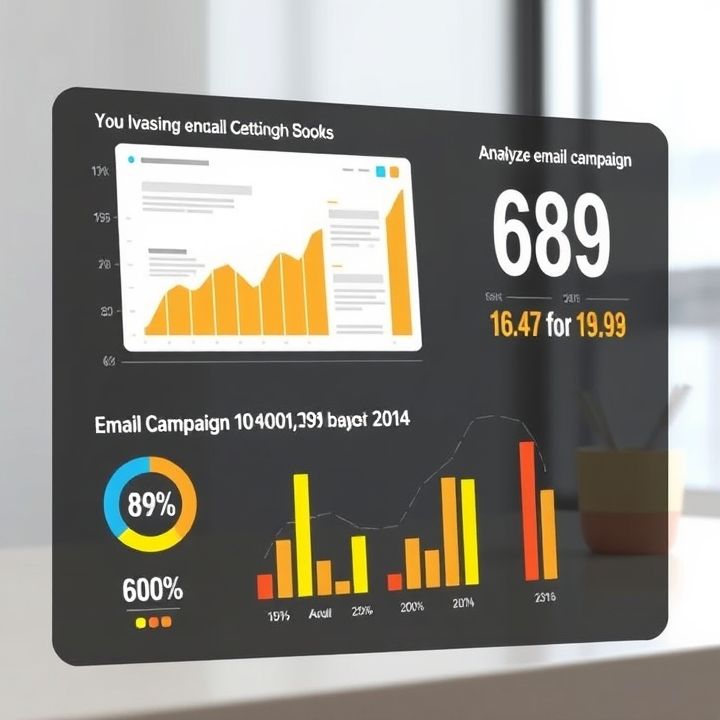Table of Contents
- Introduction
- Understanding and Segmenting Your Audience
- Maintaining a Clean and Updated Email List
- Optimizing Email Content for Deliverability
- Ensuring Proper Authentication with SPF, DKIM, and DMARC
- Monitoring and Managing Sender Reputation
- Utilizing a Reliable Email Sending Platform
- Analyzing Deliverability Metrics and Analytics
- Implementing a Feedback Loop with ISPs
- Conclusion
- Frequently Asked Questions
Introduction
In the fast-paced world of digital communication, achieving flawless email deliverability can feel like unlocking a secret treasure. Whether you’re crafting a marketing campaign or sharing a newsletter, ensuring that your emails smoothly land in the inbox rather than the spam folder is crucial for success. Are you ready to delve into the strategies that guarantee your email messages make it to their intended destinations?
| Key Benefits | Challenges Overcome |
|---|---|
| Reach a wider audience | Spam filters |
| Improve engagement rates | List management |
| Build trust with recipients | Content optimization |
Stay on this journey as we explore tried-and-true methods to ensure your emails not only reach their targets but also engage and convert. Dive into this article to uncover the secrets to mastering email deliverability!
Understanding and Segmenting Your Audience
Understanding and segmenting your audience is a crucial strategy for improving email deliverability. By recognizing the specific needs and preferences of different groups within your audience, you can tailor your email communications to be more relevant and engaging. This personalization increases the likelihood of your emails being opened and acted upon, thereby enhancing deliverability rates.
Begin by analyzing data collected from various touchpoints, such as website interactions, past purchase behaviors, and engagement metrics. This information can provide valuable insights into your audience’s interests and demographics. Based on this data, create detailed audience segments that can include criteria like location, purchasing history, or engagement levels with past emails. Once segmented, craft distinct email campaigns for each group, focusing on content that resonates with their specific needs and preferences.
By segmenting your audience, you not only improve engagement but also reduce the chance of your emails being marked as spam. When recipients find your content valuable, they are more likely to interact with it positively, thus enhancing your sender reputation and ultimately leading to better deliverability outcomes.
Maintaining a Clean and Updated Email List
Maintaining a clean and updated email list is crucial for overcoming common email deliverability challenges. One effective strategy is to regularly audit your email list to remove inactive or unengaged subscribers. This helps ensure that your messages are reaching those who are truly interested and minimizes the risk of your emails being marked as spam.
Employing a double opt-in process can also enhance the quality of your email list. This requires subscribers to confirm their email address after signing up, ensuring that they are genuinely interested in receiving your emails.
Additionally, segmenting your email list based on user preferences and behavior can improve open and click-through rates. This targeted approach allows you to send relevant content to specific groups, increasing engagement and reducing the likelihood of your emails being ignored or deleted.
Regularly updating and verifying email addresses is another key tactic. Use email verification tools to identify invalid or temporary addresses, and encourage subscribers to update their information periodically.
By implementing these strategies, you can maintain a healthy email list that supports successful email deliverability and fosters stronger connections with your audience.
Optimizing Email Content for Deliverability
Optimizing email content for deliverability is a crucial step in ensuring that your messages reach the intended inbox. One primary strategy involves maintaining a clean and up-to-date email list. This helps in reducing bounce rates and avoiding the labeling of your emails as spam. Personalizing your emails can also significantly improve deliverability. By addressing recipients by their name and tailoring the content to their interests, you create a more engaging experience that lowers the risk of your email being ignored or deleted.
Another essential tactic is to craft a compelling subject line that accurately represents the content within. Misleading or clickbait-style subject lines can lead to increased spam complaints. Additionally, ensuring that your email content is relevant and valuable to your audience enhances engagement rates. Avoid excessive use of images, links, and complex HTML, as these can trigger spam filters.
Lastly, always test your emails across different email clients and devices before sending them out. This ensures that your content displays correctly and is not automatically relegated to a junk folder due to technical issues. By adhering to these strategies, you increase the likelihood of your emails being successfully delivered and read.
Ensuring Proper Authentication with SPF, DKIM, and DMARC
Ensuring proper authentication is crucial for overcoming common email deliverability challenges, and this process typically involves implementing SPF, DKIM, and DMARC protocols.
SPF, or Sender Policy Framework, allows domain owners to specify which mail servers are permitted to send emails on behalf of their domain. This step adds a layer of verification that helps recipient servers recognize authorized senders and reject bounces and spoofed emails.
DKIM, or DomainKeys Identified Mail, complements SPF by adding a digital signature to outgoing emails, thereby verifying that the email has not been altered during transmission. This signature confirms the legitimacy of the sender and assures the integrity of the message contents.
Lastly, DMARC, or Domain-based Message Authentication, Reporting, and Conformance, builds on SPF and DKIM by providing a mechanism for domain owners to publish policies regarding email authentication and delivery. DMARC helps in specifying the action to be taken when these checks fail and provides feedback on the emails sent from the domain.
Together, these three protocols form a robust framework to enhance email deliverability, protect against phishing attacks, and ensure that emails reach their intended recipients effectively.
Monitoring and Managing Sender Reputation
Monitoring and managing sender reputation is pivotal to overcoming email deliverability challenges. One of the key strategies involves regularly checking your sender score, which is a measure of your email-sending reputation. A high sender score indicates that your emails are likely to be delivered to the inbox, while a low score can lead to emails being flagged as spam. It’s essential to ensure your email lists are up-to-date and free of inactive or incorrect addresses to avoid hard bounces, which negatively impact your reputation. Additionally, using authentication methods like SPF, DKIM, and DMARC can help verify your identity, thereby improving trust and reputation with ISPs.
Another crucial aspect is maintaining consistent email-sending patterns. A drastic increase in the number of emails sent could trigger spam filters, so it’s important to gradually scale your campaigns. Monitoring feedback loops from ISPs allows you to see when recipients mark your emails as spam, providing the opportunity to rectify any issues with content or sending practices early on. Being proactive in managing your sender reputation fosters better deliverability and engagement, ensuring your emails reach their intended audience effectively.
Utilizing a Reliable Email Sending Platform
Utilizing a reliable email sending platform is crucial for overcoming common email deliverability challenges. These platforms provide advanced tools and technologies that enhance the deliverability rates of email campaigns. A trustworthy platform typically offers features such as IP warming, reputation monitoring, and extensive analytics, all of which play a significant role in ensuring that emails reach their intended recipients’ inboxes. Using a platform with a strong infrastructure can prevent emails from being flagged as spam, thus preserving the sender’s domain reputation.
Moreover, a reliable email platform adheres to industry best practices and compliance standards such as CAN-SPAM, GDPR, and other regulations, safeguarding against potential legal pitfalls. By leveraging the services provided by a professional email sending platform, businesses can focus on crafting engaging content and targeting the right audience without the constant worry of deliverability issues.
Additionally, these platforms often offer segmentation tools, which enable sending personalized content to specific user groups, enhancing engagement and minimizing unsubscribe rates. By investing in a reputable email sending platform, businesses not only ensure better deliverability but also boost the overall effectiveness of their email marketing strategy.
Analyzing Deliverability Metrics and Analytics
Analyzing deliverability metrics and analytics is crucial for understanding and overcoming email deliverability challenges. It allows businesses to gain insights into how their emails are performing and adjust strategies accordingly. Key metrics to examine include open rates, click-through rates, bounce rates, and spam complaints. Open rates indicate how many recipients are actually engaging with the emails, while click-through rates reveal how effective the content is at driving action. High bounce rates can signal issues with the email list, such as outdated or incorrect addresses.
Spam complaints indicate how often recipients are marking emails as spam, a serious issue that can harm sender reputation. By monitoring these metrics regularly, businesses can identify patterns and issues that may be affecting email deliverability. Using tools like A/B testing can help optimize subject lines and content to improve engagement. Furthermore, understanding the sender score and maintaining a clean email list by removing inactive users can prevent common pitfalls. Ultimately, ongoing analysis of these metrics enables businesses to fine-tune their strategies, ensuring that their emails reach the intended audience effectively and consistently.
Implementing a Feedback Loop with ISPs
Implementing a feedback loop with Internet Service Providers (ISPs) is a crucial strategy in the realm of email deliverability. This process involves setting up a communication channel with ISPs to receive notifications about any issues concerning the emails you send. When an email recipient marks your message as spam, the ISP will inform you through this feedback loop. This allows you to make immediate and necessary adjustments to your email marketing strategies.
By analyzing the data received from ISPs, you can identify patterns or common complaints and adjust your email content, frequency, or recipient list accordingly. It also provides insights into the types of emails that trigger spam reports, which can help in refining your content to better cater to your audience’s preferences.
Furthermore, maintaining an active feedback loop helps enhance your sender reputation. It illustrates a proactive approach in taking responsibility for the content you distribute, which ISPs generally favor. This can contribute to improved deliverability rates and increased trust with email providers, ensuring your messages reach the intended inboxes rather than being sidelined to the spam folder.
Conclusion
Conquering the complexities of email deliverability is vital for ensuring your message reaches its intended audience. By diligently implementing strategies like audience segmentation, maintaining a clean email list, and optimizing your content, you significantly boost the likelihood of successful delivery. Furthermore, authentication protocols such as SPF, DKIM, and DMARC, coupled with robust sender reputation management, provide a strong foundation for establishing trust with email providers. Partnering with reliable email sending platforms and rigorously analyzing deliverability metrics also plays a crucial role in refining your approach, allowing for continual improvement.
Additionally, maintaining an open feedback loop with ISPs facilitates the proactive adaptation of your strategies, based on real-world data and recipient feedback. Collectively, these proven tactics not only enhance deliverability but also elevate overall engagement and effectiveness of your email campaigns. By consistently applying these best practices, businesses can navigate the ever-evolving landscape of email marketing with confidence, ensuring their communications are impactful and their objectives are met. Mastering these strategies ultimately transforms email deliverability from a challenge into a powerful asset for business growth and customer connection.














